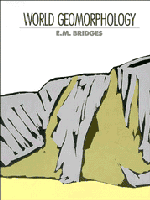10 - Geographical implications of major geomorphological features
Published online by Cambridge University Press: 05 June 2012
Summary
The landforms of the Earth have been described within the framework of the major physiographic divisions and provinces of each lithospheric plate. Although the boundaries of the plates are well established and most people would agree about the major physiographic divisions, there is less agreement about the boundaries of provinces, and different authors may take slightly different areas. An aim of geomorphological analysis is to sub-divide the Earth's surface into areas with similar geological and geomorphological development, to provide a meaningful basis for discussion and explanation of present landforms.
This theme is but one of the many facets of interest in geomorphology, as is pointed out by Gregory (1987). Essentially, the foundation of the modern study of landforms begins with the writings of W.M. Davis whose evolutionary approach dominated the first half of the 20th century. Problems with dating the various stages in a denudation chronology and over-enthusiastic correlation of surfaces over large distances led to disillusionment with this approach. This coincided with a growth of interest in the natural processes involved and this approach has tended to dominate geomorphology work during the last 40 years.
The emergence of the concept of plate tectonics and its potential for providing an explanation of the distribution of the continents has given renewed encouragement to the study of the large-scale features of the Earth's surface; the features which formed the framework of the geomorphological analysis of the previous chapters.
- Type
- Chapter
- Information
- World Geomorphology , pp. 248 - 252Publisher: Cambridge University PressPrint publication year: 1990



